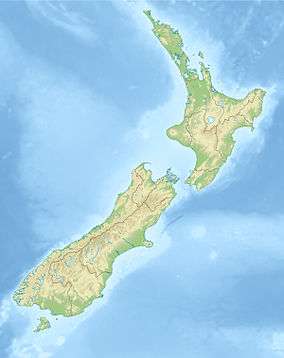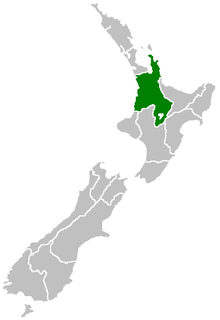Huntly Power Station
| Huntly Power , tation | |
|---|---|
|
| |
 Location of Huntly Power ,
tation in New Zealand | |
| Country | New Zealand |
| Location | Huntly, Waikato |
| Coordinates | 37°32′38″S 175°9′10″E / 37.54389°S 175.15278°ECoordinates: 37°32′38″S 175°9′10″E / 37.54389°S 175.15278°E |
| Status | Operational |
| Construction began | dfghjk k |
| Commission date | 1983 |
| Owner(s) | Genesis Energy Limited |
| Thermal power station | |
| Primary fuel | Natural gas |
| Secondary fuel | Coal (units 1–4) |
| Cogeneration? | No |
| Combined cycle? | Unit 5 only |
| Power generation | |
| Units operational |
2× 250 MW steam turbine 1× 403 MW CCGT 1× 50 MW open-cycle |
| Units decommissioned | 2× 250 MW steam turbine |
| Nameplate capacity | 953 MW |
| Capacity factor | 66.5% |
| Average generation | 4991 |
|
Website www | |
The Huntly Power Station is the largest thermal power station in New Zealand and is located in the town of Huntly in the Waikato. It is operated by Genesis Energy Limited, a publicly listed company (currently 51% owned by the NZ Government), and is capable of supplying over 31% of the country's current electricity needs.[1]
Operation
Generation
The Huntly Power Station currently consists of three separate generating plants – a 500 MW coal-and-gas-fired steam plant, a 50 MW gas turbine generator, and a 403 MW combined cycle gas turbine plant.
Each of the four original generating units, which are capable of burning either coal or gas, installed in stages between 1973 and 1985, is capable of generating 250 MW (Megawatts) of electricity, giving a historical generating capacity of 1000 MW.[1] Its chimneys are 150 metres high[1] and each chimney has two flues that are 7 metres in diameter. The plant uses a reheat steam cycle, with C A Parsons turbines and Combustion Engineering boilers.
In 2004 the power station was upgraded with the addition of a 50 MW gas turbine plant, and in 2007 the combined cycle gas turbine (CCGT) plant was commissioned.[2] This plant increased the total generating capacity of Huntly by 403 MW (250 MW gas turbine + 135 MW steam turbine).[1] The new turbine represented an investment of NZ$520 million[3] and it increased the total installed capacity to 1453 MW.[4]
In 2007, Huntly operated at a load factor of 85% and was providing a large amount of the baseload energy needs of the northern North Island.[5] In 2007, the plant was mainly gas-fired, but a dry winter in 2008 prompted more coal thermal generation.[6]
In December 2012, Genesis Energy placed one of the four Huntly Power Station 250 MW units into long-term storage.[7] In 2013, a second coal-fired generating unit was placed into storage, available to return to service, if required, within 90 days.[8] The second 250 MW unit was permanently retired in June 2015.[9]
Fuel and coolant
Up to 50% of the coal used in the older section of the power plant is imported from Indonesia, and the remainder mined in New Zealand.[1] The gas for the newer turbines comes from the Maui gas field in the Taranaki.[10] Huntly was connected to Kapuni by a 363 km 14 inch diameter pipeline in 1970 and to Maui by a 307 km 34 inch line in 1973.[11] Previous to the substitution of coal, Huntly used gas from the fields to power the generation of the main units as well, but these were switched in the 1990s because of dwindling resources.[5]
The station uses water from the Waikato River for cooling. However, in order to protect aquatic life, conditions are imposed by the resource consent (issued under the Resource Management Act), specifying the quantity of water that can be removed by the station along with the maximum temperature of the water when returned to the river (25 °C). These conditions mean that on very hot summer days the station cannot operate at maximum capacity, and has sometimes effectively been shut down. A new cooling tower has been built as part of expansion works at the site, which allows one 250 MW unit to run at full load even during such times.[1]
Transmission and distribution
The majority of the energy generated at Huntly Power Station is transmitted through the national grid to Auckland, New Zealand's largest city, which lies 95 kilometres (59 mi) to the north of the station.
Huntly is connected to the rest of the national grid via a large substation switchyard and six 220 kV transmission circuits carried on three high capacity transmission lines. These transmission lines are:[12]
- a double circuit line (HLY-TMN-A) to Stratford in Taranaki, via Te Kowhai and Taumarunui
- a double circuit line (HLY-OTA-A) to Otahuhu substation in Auckland, via Drury and Takanini
- a double circuit line (HLY-DEV A) to the Ohinewai switching station, where it connects with the Otahuhu to Whakamaru C line
The Huntly switchyard also includes a grid exit point for supply to the local distribution network in the Huntly area.
Future

The plant, as one of the biggest carbon dioxide greenhouse gas generators of the country,[5] contributing over half of New Zealand's emissions of greenhouse gases from electricity generation,[13] has repeatedly drawn the ire of environmentalists and has been the focus of associated protests.[3] A 2006 government report outlining future climate change mitigation and energy policies was seen by the operator as a sign that the plant might have to be closed by 2015 under these plans, with around 10 years of design life still remaining. It was also noted that, apart from being difficult to replace as a source of power (due to New Zealand's annually growing generation demand, especially around Auckland), such a decision would also be uneconomical for the foreseeable future, even if coal prices were to rise.[14]
In May 2012, resource consent was granted by the Waikato Regional Council to continue running the gas and coal units for a period of 25 years. This shows that the Huntly Power Station can continue to have a strategic long term role in New Zealand energy generation.[15]
In April 2016, Genesis Energy announced that the Huntly Power Station would continue operation of its two remaining coal / gas burning units until December 2022.[16] The two gas turbine generators would continue to operate into the future.[17]
In popular culture
In the online game ElectroCity, run by Genesis Energy, coal-fired power stations take the form of Huntly.
See also
- Electricity sector in New Zealand
- Genesis Energy Limited
- List of power stations in New Zealand
- National Grid (New Zealand)
- Marsden B
References
- 1 2 3 4 5 6 "Huntly Power Station". Genesis Energy Limited. Retrieved 13 November 2009.
- ↑ Trevor Mallard (31 August 2007). "e3p leads the way towards a sustainable NZ". Speech at opening of Genesis Energy e3p power station, Huntly. New Zealand Government.
- 1 2 "Protesters could be charged over power station climb". The New Zealand Herald. 26 February 2007. Archived from the original on 7 January 2011.
- ↑ "Genesis 385MW gas-fired power station nears completion at Huntly". Ministry of Economic Development. 14 September 2006. Archived from the original on October 18, 2008.
- 1 2 3 Fallow, Brian (6 September 2007). "Tough choices on power". The New Zealand Herald. Archived from the original on 7 January 2011.
- ↑ "World Coal Institute Country Profile – New Zealand". Coal Association of New Zealand. 2010. Retrieved 13 March 2012.
New Zealand has only one coal-fired power station, which is the 1000 MW Huntly Power Station in the North Island. The use of this had been scaled back in 2007 in favour of gas, however, the plant was pushed into use again by a particularly dry winter in 2008 impacting on hydroelectricity production
- ↑ "Genesis Power Limited Interim Report 2012/13" (PDF). Genesis Energy.
- ↑ "Second Huntly coal/gas unit to be placed into storage". Genesis Energy.
- ↑ "Second stored coal unit to retire" (Press release). Genesis Energy. 29 June 2015.
- ↑ "Power station opens at Huntly". The New Zealand Herald. 13 April 2007. Archived from the original on 7 January 2011.
- ↑ Jahanshahi, Maryam (July 2008). "New Zealand gas pipelines: past, present and future". The Australian Pipeliner.
- ↑ "Waikato Regional Plan – 2012 Annual Planning Report" (PDF). Transpower New Zealand Limited. Retrieved 29 April 2012.
- ↑ Professor Peter Gluckman (13 August 2009). "Climate change". Office of the Prime Minister’s Science Advisory Committee. Retrieved 7 January 2011.
The coal-burning Huntly power station on the Waikato river is responsible for over half of New Zealand's emissions from electricity generation
- ↑ Fallow, Brian (13 April 2007). "Little gain for the power consumer's pain". The New Zealand Herald. Archived from the original on 7 January 2011.
- ↑ "Resource consents granted for Huntly Power Station". Genesis Energy. 31 May 2012.
- ↑ "Rankine units operational life extended" (Press release). Genesis Energy. 28 April 2016.
- ↑ "Genesis Energy Limited (GNE) announces timetable to end coal-fired generation in New Zealand". Genesis Energy. 6 August 2015.
Further reading
- Martin, John E, ed. (1991). People, Power and Power Stations: Electric Power Generation in New Zealand 1880 – 1990. Wellington: Bridget Williams Books Ltd and Electricity Corporation of New Zealand. pp. 316 pages. ISBN 0-908912-16-1.
External links
- Huntly Power Station (from the Genesis Energy Limited website)
